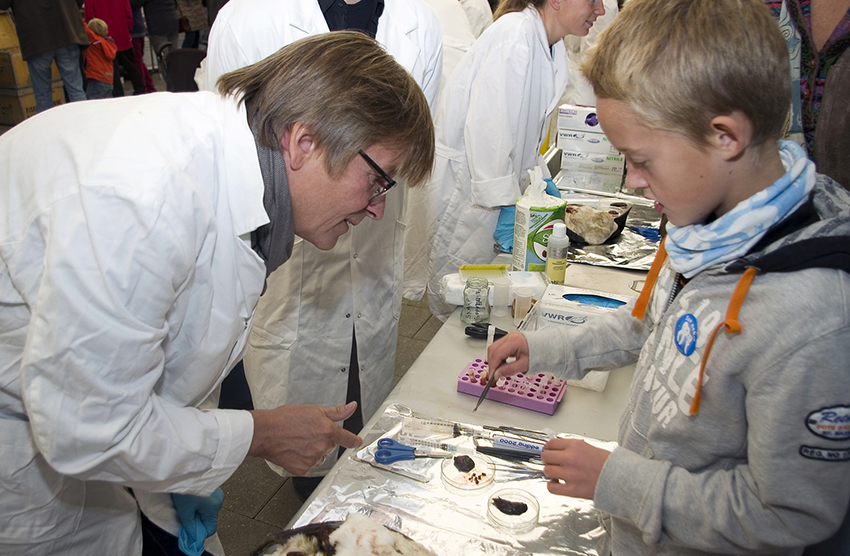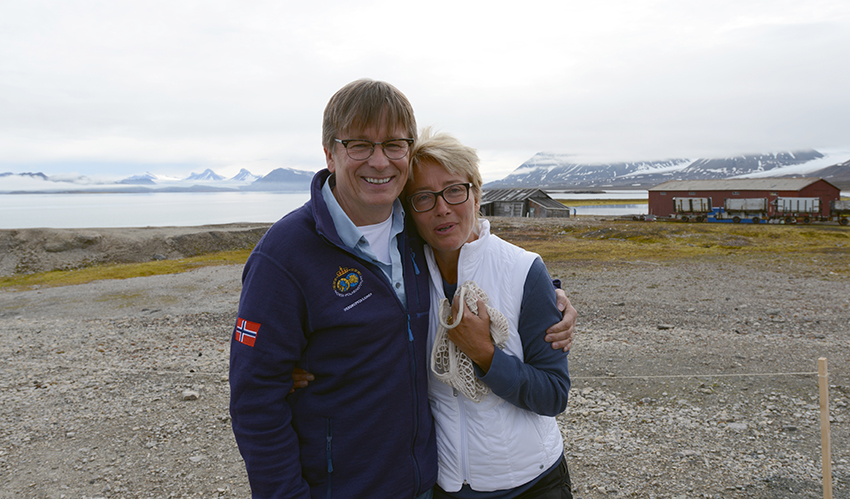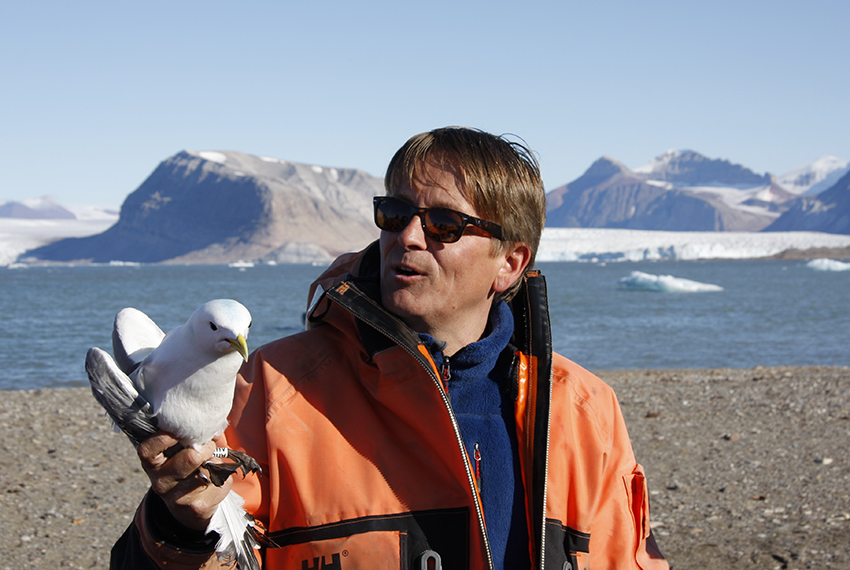Kongsfjorden’s Wingman

Geir Wing Gabrielsen with a captured goose just outside Ny-Ålesund. Photo: Kjell Tore Hansen/The Norwegian Polar Institute.
Top image: Geir Wing Gabrielsen with a captured goose just outside Ny-Ålesund. Photo: Kjell Tore Hansen/The Norwegian Polar Institute.
Kongsfjorden. Our story begins there and it will end there, but Geir Wing Gabrielsen may never be finished with the fjord. Although he has probably spent more seasons doing fieldwork there than anyone else, he still has projects lined up.
28 March 2022
Text: Helge M. Markusson/Fram Centre
“I have three years to cruise ashore, letting younger talents take the helm and at the Environmental Pollutants section of the Norwegian Polar Institute. I’ll stay on as a senior scientist until I retire. There are some very specific things I want to do, and at the top of the list is writing a book about my years in Kongsfjorden. It will be about working there, about research and monitoring in Kongsfjorden. This includes climate change, escalating plastic and environmental pollution, and all the other things I’ve witnessed and experienced.”
Characteristically, Gabrielsen gets straight to the point, eager to convey what he is working on, essentially always on the ball. He may wander off on a tangent about fast American cars that go vroom, but will soon revert to talking about his research.

The formative years
Gabrielsen grew up in Honningsvåg (Finnmark), where he worked at the fish processing plant. His future as a fisherman was staked out. Fishing boats were interesting. Schoolwork, not so much.
“The only good teacher I had in primary school was Herbjørg Wassmo, the author. I still remember her reading to us. Saturday was a school day and she would end the last lesson by reading aloud. To this day she calls me ‘little Geir’.”
But when he was 12, the family moved to Kirkenes, where people took education more seriously. Gabrielsen discovered books and a desire to learn. This led to secondary school in Kirkenes and Harstad and eventually to University of Tromsø in 1974.
First visit to Kongsfjorden
Gabrielsen did his master’s thesis at the Department of Arctic Biology under Professor Arnoldus Schytte Blix. The topic was fear reactions in ptarmigans. When an animal is frightened, its body reacts with a “fight-or-flight” response that usually involves an increase in heart rate. Gabrielsen studied ptarmigans in Karlsøy and found an odd reaction in nesting ptarmigan hens. When people approached, the hen’s heart nearly stopped, slowing to just 10-20 beats per minute, the opposite of what was expected. The project prompted a trip to Svalbard.
“There’s a difference between willow ptarmigans and Svalbard rock ptarmigans,” Gabrielsen explains. “They react differently when threatened. So I was sent to Svalbard to observe how nesting hens reacted when approached by people.”
The trip, in 1981, would mean his first encounter with Kongsfjorden.
“I had heard a lot about Ny-Ålesund from my parents and their friends, who had lived there for a few years in the early 1950s. My father was an electrical engineer and my mother looked after the director’s children. When we went on holiday, we visited people they had met there, people from Sulitjelma, Mo i Rana, Harstad – places with close ties to Ny-Ålesund. I remember them sitting and talking about life in Ny-Ålesund, and we had photos on our walls, so naturally I was interested in that place.”
The young researcher crossed Kongsfjorden to Blomstrandhalvøya, where he caught several ptarmigan hens.
“We outfitted nesting hens with backpack containing a transmitter for heartrate and breathing and I monitored the signals from 100-200 metres away.”
What they discovered was quite startling.
“When we threatened Svalbard rock ptarmigans the same way as we had done in Karlsøy, it became apparent that they had not developed the same reactions, presumably because they face fewer threats than willow ptarmigans on the mainland.”
Sojourn in the United States
The ptarmigan studies eventually led to Gabrielsen’s master’s thesis, which in turn led him to the United States (where he learned to appreciate fast cars that go vroom). He was offered an opportunity to study at the Massachusetts Institute of Technology (MIT) in Boston. His field was biotechnology and the focus was on sudden infant death syndrome among young children at Massachusetts General Hospital. By registering babies’ reactions to sounds, he could measure how they responded while asleep.
“One baby stopped breathing and was gone for nearly two minutes,” says Gabrielsen, reaching for a bookcase in his office on the fifth floor at the Fram Centre and pulling out an article he published about the study. How did he get from sudden infant death syndrome to the Norwegian Polar Institute?
“In the autumn of 1983, Fridtjof Mehlum came to Boston and asked me to apply for a PhD scholarship at the Norwegian Polar Institute, actually the institute’s first scholarship in biology. They had secured funding from the PRO MARE programme and wanted me to study energy metabolism in seabirds in Svalbard.”
Said and done! Gabrielsen went home and embarked on doctoral studies of seabirds’ adaptation to cold environments and their energy expenditure. Using the new double-labelled water method (where both hydrogen and oxygen are marked with radioactive isotopes), he gathered knowledge about seabirds’ food intake and energy consumption that made it possible to estimate how much food the birds take from the sea.
First in Tromsø
Fast forward to 1994. Gabrielsen has completed his PhD and moved back to Tromsø. For the past four years he has been working at the Norwegian Institute for Nature Research within the Coastal Ecology research programme.
Two years earlier, after intense lobbying from the north, Parliament decided to move the Norwegian Polar Institute from Oslo to Tromsø. The decision was not well received among the employees: virtually none of them wanted to move. It appeared that the Institute would have to be rebuilt from scratch.
Geir Wing Gabrielsen became one of the very first employees at the Norwegian Polar Institute in Tromsø, working as an ecotoxicologist. He and Christian Lydersen and a few other early recruits moved into temporary premises on Storgata. Three years later, they relocated to the newly constructed Polar Environment Centre, now named the Fram Centre.
As it turned out, there was no need to start from scratch in Tromsø. Regardless of what “the southerners” thought, by the mid 1990s the city had a well-established research environment.
“Yeah, Christian – who was studying marine mammals – had a good working relationship with Tore Haug at the University. I worked close to Rob Barrett at Tromsø Museum and Kjell Gunnar Erikstad at NINA and many others. It was a superb foundation for developing a research community and there’s no doubt that the University and NINA played important roles in establishing the academic environment in Tromsø.”
The researchers up north seized this opportunity to show their mettle.
“There were a lot of people with guts,” says Gabrielsen. “We were good at securing funding for projects and, not least important, we recruited bright students who helped us grow competence in Tromsø. And we published! The Polar Institute was transformed after its move to Tromsø. Remember, before the move, the Institute employed lots of geologists, a legacy from the time when it was under the Ministry of Industry (until 1979). Their mapping efforts were intended to support industrial development. When the Ministry of the Environment took over responsibility, the focus changed, shifting more toward biology.”

Communication at many levels
Geir Wing Gabrielsen is probably the researcher at the Norwegian Polar Institute who is best known to most people. This is undoubtedly because he takes pains to write and speak so his intended audience understands. He writes academic papers and reports, commentaries in daily papers, feature articles and lectures, and he always says yes when journalists call. But he has also authored books for children. Communication is all about using language that gets the message across.
“Explaining difficult concepts to children teaches you how to give answers that work,” he says. “I helped produce school newsletters in Kirkenes and Harstad. That’s where someone told me: ‘If your grandmother doesn’t understand what you’ve written, you’re doomed!’ I never forgot that. I learned to popularise, and I see many scientists who struggle with precisely that issue.”
The students’ enthusiasm
Gabrielsen has served as advisor to about 80 master’s students and nearly 20 doctoral students. He was one of the first people recruited to lecture at UNIS (the University Centre in Svalbard) when it started up in 1994. “I could feel the students’ enthusiasm,” he reminisces. “They were eager to learn about the Arctic and the natural environment. It was inspiring!” He leans forward, eager to make his point: “The fantastic thing about students is that they come in and help us build new knowledge in our own fields.”
Gabrielsen stresses the importance of connecting with younger age groups. He has published two popular science books for children in collaboration with author Kirsti Blom, and another children’s book about plastics is coming soon. Through initiatives such as the Fram Centre school tour “The Scientists Are Coming” and “The Cultural Schoolbag” (den Kulturelle Skolesekken), he has talked to thousands of students at 120 secondary schools in Trøndelag, northern Norway, and Svalbard about environmental pollutants and plastic in the ocean.
Plastics on the agenda
In 2013, Gabrielsen wrote a feature article about plastic pollution in the ocean for the daily paper Adresseavisen. His objective was to alert people at the Norwegian Environment Agency to the problem. Back then, marine plastic waste was not a topic of public debate. Now it is viewed as one of our main environmental challenges.
“Yeah, I’ll take some of the credit for that,” he says. “We all became aware that plastic is a threat to the environment. I was summoned to give lectures for the Ministry of Climate and Environment and the Environment Agency, and over the next few years I was invited to speak all over, at home and abroad. Marine plastic was a wake-up call for many.”

Back to Kongsfjorden
Our story started in Kongsfjorden, and that is where it ends.
“When I first went there, 40 years ago, Kongsfjorden was covered with ice. There weren’t many scientists in Ny-Ålesund,” says Gabrielsen, “and we who were there had to help the Kings Bay staffers with odd jobs like stocking and running the shop when tourists arrived. It was a different time.
“Ny-Ålesund has played an important role in Norwegian and international research. Looking back at the past 40 years as a whole, you see enormous change in the climate. The most dramatic shift happened between 2005 and 2007, when warm water flowed in from the Atlantic and Kongsfjorden was suddenly open. There’s much less sea ice in the fjord now. Blomstrandhalvøya is no longer a peninsula, but an island. The glaciers have retreated: Kronebreen has receded three kilometres! The ecosystem has changed. We’re seeing new species, whales and birds. What used to be an Arctic fjord is now an Atlantic fjord. I wouldn’t have believed that could happen, and not so quickly.”
Geir Wing Gabrielsen pauses a moment, then continues, “As I say, having spent 40 years in Kongsfjorden gives me a unique opportunity to bear witness to these changes. That’s what I want to write about. I should be finished by the time I’m seventy. But I’ll have other things to do after that, so I hope I can keep an office here at the Fram Centre.”
Others on Geir Wing Gabrielsen:
Respected
“Geir’s research on avian physiology, ecotoxicology and plastics in the environment has contributed new knowledge published in respected scientific journals. In this regard, Geir is well-known internationally.
We colleagues at NTNU and UNIS have frequently had the pleasure of hearing his lectures, delivered with great professional skill and enthusiasm. Geir and I co-organised the Svalbard Course for many years, so I’ve witnessed his remarkable ability to summarise and popularise complex environmental issues for participants from all kinds of backgrounds. His ability to talk to people, create a friendly atmosphere, and articulate take home messages is greatly appreciated by all his listeners.
Geir’s deep involvement in Ny-Ålesund and Kongsfjorden has been an asset for important national projects, colleagues, and people attending a wide variety of courses. His personality makes him a natural centre of attention: he’s accommodating, he listens, and it’s always fun to be with him on excursions and research cruises, when teaching or at the pub.”
Geir Johnsen, Professor of Marine Biology, NTNU and UNIS
Always an open door
“Geir has worked broadly throughout his time at the Norwegian Polar Institute. He has tackled many issues: how Arctic ecosystems are affected by climate change, environmental pollutants and plastic, and how animals adapt to the challenges they face in the Arctic environment.
He truly wants to understand. He’s an incredibly positive person. Despite his busy schedule, I’ve never heard him say he doesn’t have time. His door is always open and he greets people with a smile. He’s got the internal drive required to do research; he’s persistent and has faith that things will turn out well.
He trusts his co-workers 100% and delegates responsibility to others, which boosts their motivation and makes them want to do a good job.”
Heli Routti, Environmental Pollutants Section, Norwegian Polar Institute